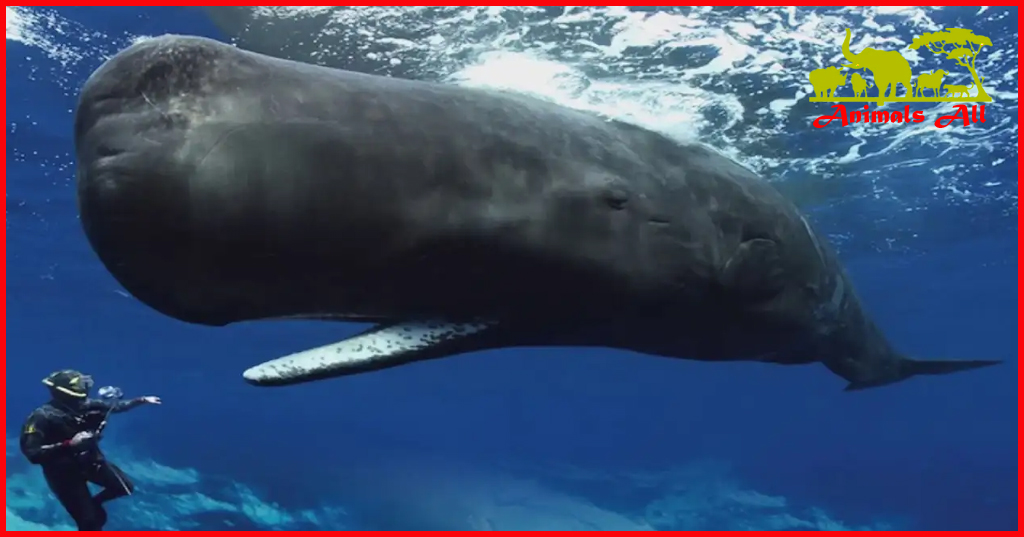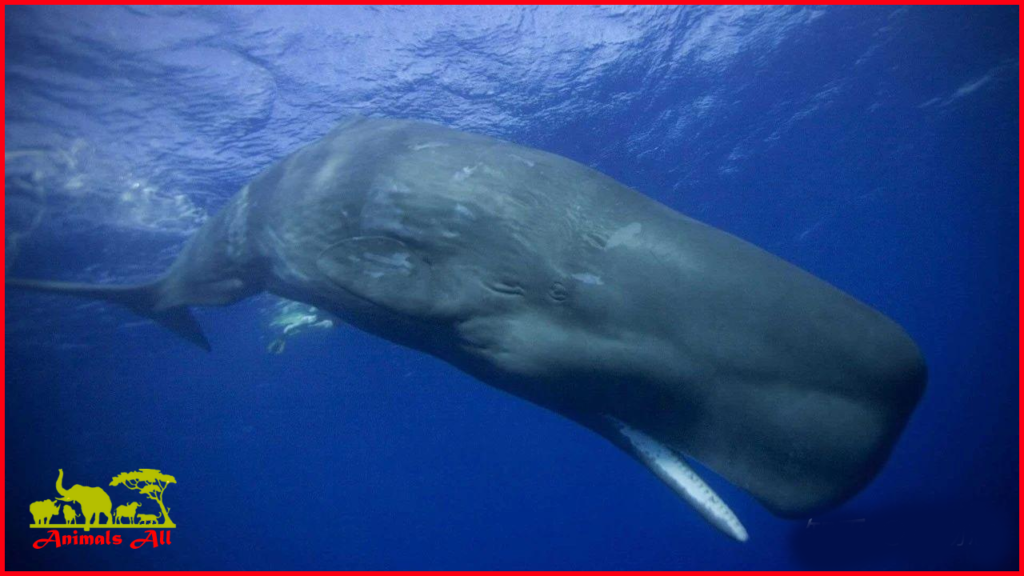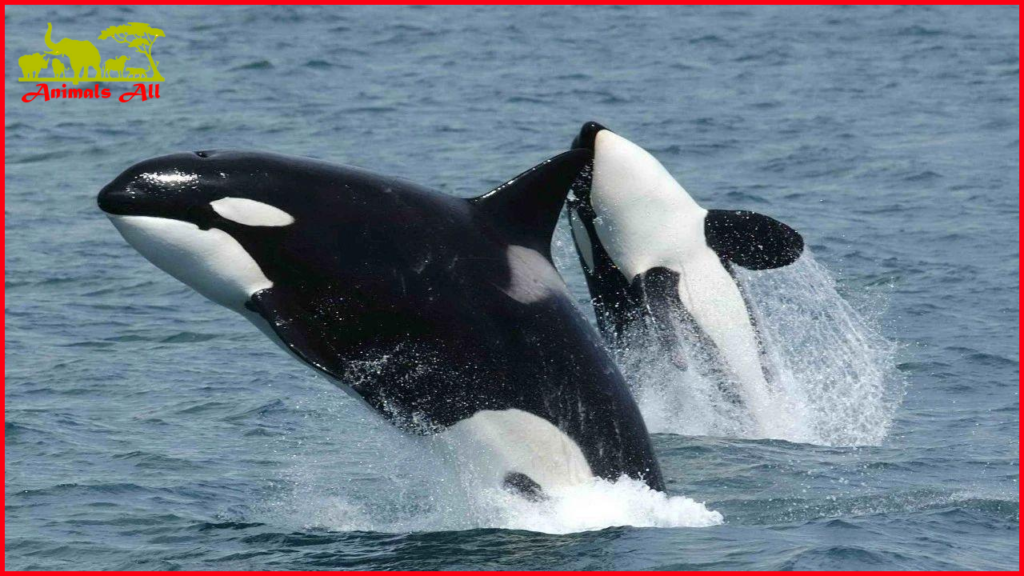
Sperm whale teeth are larger than killer whales.
The sperm whale teeth are largest toothed whale in existence. The average length of a mature male whale is 15 to 16 meters and weighs more than 40 tons. The average length of a mature female whale is 11 meters and weighs 14 tons . The largest sperm whale on record is over 20 meters long and weighs over 90 tons.
The sperm whale is firmly in the position of the largest toothed whale. The second largest toothed whale, Bryde’s beaked whale, has a maximum length of only 12.8 meters. Despite this, the sperm whale also has natural enemies, and their natural enemies are killer whales . In addition, pilot whales and false killer whales have also been recorded attacking or harassing sperm whales. But they are not consider natural enemies. So, why can sperm whales grow so big but still not beat killer whales?

Body size comparison
Killer whales are the largest toothed whales besides sperm whales and several beaked whales. They are also the largest dolphins (killer whales belong to the family Delphinidae of the suborder Odontoceti). For example, the Antarctic A-type killer whales have an average body length of 7.3 meters and weigh about 5 tons. While females are 6.4 meters long and weigh 3.5 tons . The largest killer whale ever record in scientific research is 9 meters and 11.6 tons. The largest killer whale ever recorded in hunting is 9.45 meters and 13.4 tons.
Mature sperm whales are indeed large. But when they are just adults, males are only 10-11 meters long and weigh 11-12 tons. While females are 8-9 meters long and weigh more than 6 tons, which is not a big size advantage over killer whales, especially females. It is entirely possible for a large male killer whale to be larger than a smaller adult female sperm whale.

Software and hardware analysis
Although sperm whales are toothed whales, their teeth have been severely degenerated due to long-term specialization in preying on cephalopods. Only a few residual teeth remain in the upper jaw, which are not functional. The lower jaw is disproportionately narrow, with 18-26 lower teeth on each side. Which can be insert into the tooth sockets of the upper jaw. The connection between the lower jaw and the skull is not very strong. So the lower jaw is very flexible and can bite some larger targets.
Sperm whales are known to hunt giant squid, but in fact, their main food is medium-sized squid. In the waters of the Galapagos Islands, sperm whales prey on squid weighing between 12 and 650 grams.
Compared to sperm whales, killer whales have much better teeth. They have a mouth full of conical fangs. Their upper and lower teeth can bite normally, and their jaws are very powerful. Therefore, although killer whales are smaller than sperm whales, they are more powerful.

What makes killer whales better than sperm whales is their temperament. Sperm whales are specialize in eating squid, so they are not very aggressive towards other marine animals. Killer whales, as the dominant species in the ocean today, are very aggressive. Different types of killer whales are adapt to hunt different prey, including various fish, whales and pinnipeds. The largest baleen whales, such as blue whales and fin whales, are on their menus, and sperm whales are no exception. Therefore, when killer whales and sperm whales encounter, one wants to kill the other, while the other only wants to protect itself, and the sperm whale loses in terms of momentum.
Both sperm whales and killer whales move in groups. Their groups are matriarchal , consisting of mothers and offspring. The group size is mostly within 10 individuals, but the upper limit of killer whale groups seems to be higher, with large groups of more than 30 individuals, while sperm whale groups have about 20 individuals.
In terms of social structure, a big difference between the two is that adult male killer whales never leave their mothers and continue to stay in the birth group. Male sperm whales will leave the group when they are 4-21 years old . Young male whales form bachelor alliances, while old male whales live a lonely life.

Predation Example
The target of the killer whale group’s attack on the sperm whale group is the young sperm whales, and the sperm whales form a “rose formation” to fight against it . That is, the adult female sperm whales face their heads inward and their tails outward, surrounding the young individuals in the middle, and slapping their powerful tails to deter the killer whales from approaching. However, the defensive effect of the rose formation is not ideal . Because the young sperm whales are too weak, killer whales usually always find an opportunity to kill one or more of them.
Killer whales are all-around hunters with both endurance and speed. They can swim at speeds of up to 45 kilometers per hour and cruise at speeds of up to 20 kilometers per hour. However, sperm whales have large heads and small bodies, which are not conducive to swimming, and their swimming speed is only 37 kilometers. Therefore, when sperm whales encounter killer whales, they cannot escape by swimming.
Sperm whales are good divers and can dive to a depth of 2,000 meters, while killer whales have poor diving ability and mostly stay within 100 meters below the sea surface . Deep diving seems to be a good way for sperm whales to escape from killer whales. However, although sperm whales have outstanding diving ability, preparations before deep diving are indispensable. When encountering killer whales, they cannot dive immediately in a hurry , so they mainly gather in place. In addition, young sperm whales cannot dive yet, so in order to protect their young whales, female whales can only stay on the water and deal with killer whales.

When the killer whale group is too large, adult female sperm whales may also be kill by killer whales. In an extreme example, a sperm whale group was almost wipe out. In 1997, in an attack in California, the United States, 35 killer whales attacked 9 sperm whales (only one juvenile whale, the rest were adults and sub-adults). As a result, the largest female sperm whale was kill, and most members of the sperm whale group were injure, several of them seriously injure. Researchers speculate that at least 3 to 4 survivors will eventually die from their injuries.
When a sperm whale group is besieg by killer whales, nearby male sperm whales will come to support them upon hearing the news, not just the father of the child. This is an altruistic behavior, and as long as all male whales insist on doing so, it will be beneficial to their own offspring and the entire sperm whale population. Sometimes, the support of male sperm whales can wear down the patience of killer whales as soon as possible, causing them to let the sperm whale group go. Sometimes, the appearance of male sperm whales cannot stop killer whales from killing.

As they are inferior to their opponents in both attack power and flexibility, sperm whales have the advantage of size but cannot do anything to killer whales. They often need a relatively large number advantage to protect their young whales. Once, eight killer whales attacked a group of sperm whales. More than 30 male sperm whales came to rescue them. The big male whales stood in front of the killer whales and tried to cover the escape of the female sperm whales and their young whales. They changed three formations. In the end, the sperm whales used the boat as a cover to repel the killer whales.
The size advantage of adult male sperm whales is too large, and the attack power is significantly stronger than that of females. It is no problem to protect themselves in front of killer whales. So far, there is no record of killer whales killing adult male sperm whales.
Sometimes, killer whales will steal food from male sperm whales. Once, two female killer whales tried to rob an adult male sperm whale, but failed. Another time, a sperm whale killed a 300-kilogram giant squid in the deep sea. When it brought it to the surface to enjoy, it was snatch away by six killer whales. The sperm whale, who had just finish a deep dive, was exhausted and had to admit that it was unlucky.
Studies have shown that even adult male sperm whales acting alone will become uneasy when hearing the sounds of killer whales , and may even form alliances to jointly defend against predators. This shows that even male sperm whales are afraid of killer whales.
In the animal world, although the bigger the better, size is not the only determining factor. Killer whales make up for their smaller size by their aggressiveness and aggression . Although sperm whale teeth are larger than killer whales. They can only become prey to killer whales.

Sperm whales have been severely deplet today, with only three species remaining: sperm whales, pygmy sperm whales and dwarf sperm whales. Some prehistoric sperm whales were very predatory, such as Leviathan , which was over 17 meters long and weighed an estimated 50 tons. It had a mouth full of sharp teeth and was one of the strongest marine predators in history . If it could be resurrect, dozens of killer whales would not be its opponent, and the position of the ocean overlord would have to be replace.


One thought on “Sperm whale teeth are larger than killer whales.”
Comments are closed.